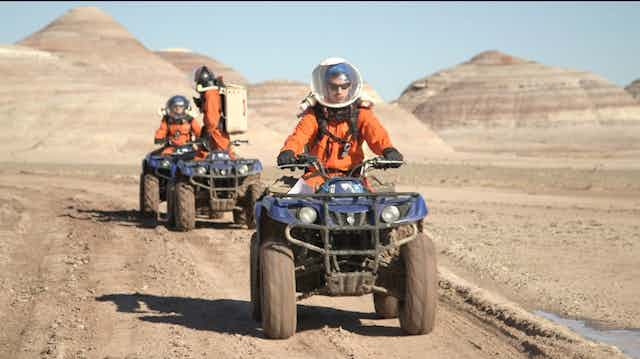According to Martin Rees, the Astronomer Royal, establishing a permanent presence beyond Earth is the first step humans will take towards the “divergence into a new species”. Plans to visit and even colonise Mars are no longer the subject of science fiction novels.
But before we can do that, we need to understand how humans can survive and thrive on Mars. Some of that we can do right here on Earth by simulating Mars-like conditions.
In the most recent such experiment, I was the crew commander of such an expedition in the high-altitude desert of Utah, the most Mars-like place on Earth. The crew were comprised of seven – two scientists, two engineers, a medical doctor, a journalist and a humanoid robot.

We were based at the Mars Desert Research Station, a facility replicating a planned NASA surface base on Mars. The Habitat Module was our home for 14 days. A two storey silo-shaped building with lab areas and living spaces, eight metres in diameter, it is built to fit atop a heavy-lift launch vehicle. Attached are a greenhouse and observatory.
With only 50m2 of living space in the Habitat Module, the idea of personal space was completely left behind as soon as we entered the simulation. If you were not within eye-shot of someone, you were certainly within ear-shot. If there were any disagreements within the crew, there really was nowhere to escape to. You simply could not just step outside for a breath of fresh air. Just to leave the Habitat Module required agreements with Mission Support the day before. Then you had to don a spacesuit that would act as a barrier between you and the harsh outside world. In such a tight and intense environment, it was easy for the smallest conflict to get amplified.
Within the crew, there were nearly two dozen research projects to conduct over the two-week expedition. One study was on extreme weather-testing of particular micro-organisms shortlisted for terraforming Mars – that is, for transforming the Martian atmosphere and surface into something more hospitable for humans. These extremophiles, already weather-tested in the arctic conditions of Svalbard and Greenland, were placed in the harsh and nutrient-poor desert soils, analogous to those on Mars, to see how they survived.
Another experiment involved improving protocols in tele-surgery and tele-anaesthesia with the Concordia Base in Antarctica and several other groups around the world. Those that go to Mars are not going to be experts in every medical or surgical field. There may sometimes be the need to carry out procedures they are not familiar with. This study involved looking at the difficulties faced when experts direct non-experts through procedures via restricted telecommunications. Members of our team carried out a simulated surgery to mend a broken leg with instructions delivered via video conference.

We also had a range of hardware to test in the field. The Martian terrain and atmosphere requires specially developed technology to make work and travel possible. On this trip we trialled prototype spacesuit glove technologies that fed information about texture through the fingertips. We ran operations with a stereo camera and 3D mapping system on a rover, similar to what will be on the ExoMars rover, to capture what field operations look like across a range of Mars-like terrain. We also tested out equipment that has been developed to extract hydrogen and oxygen from the soil for producing water, breathable air, and rocket fuel.
With most of the crew members being older than me, I found myself in an interesting position as crew commander. More than anything, my main role was to maintain the fine balance of keeping everyone as equally unhappy as possible. We are not just talking about a balance within the crew itself, but also between the crew and Mission Support. Everyone wanted their pet-projects, protocols, and perfect shots, but we had limited person-hours as a unit. I had to keep a calm head and remind myself of the expedition’s priorities.

Human ingenuity has been perfecting the technology we will need on Mars, but what we can’t do is eliminate human follies. Beyond all the technical experiments performed, these simulated expeditions help prepare us to best deal with those.

